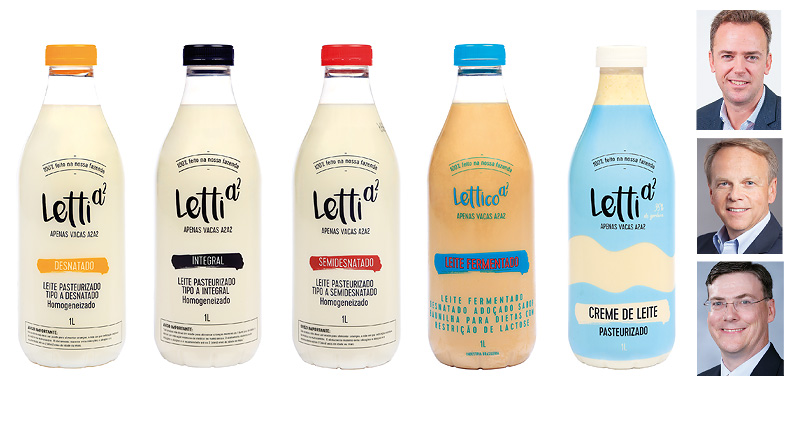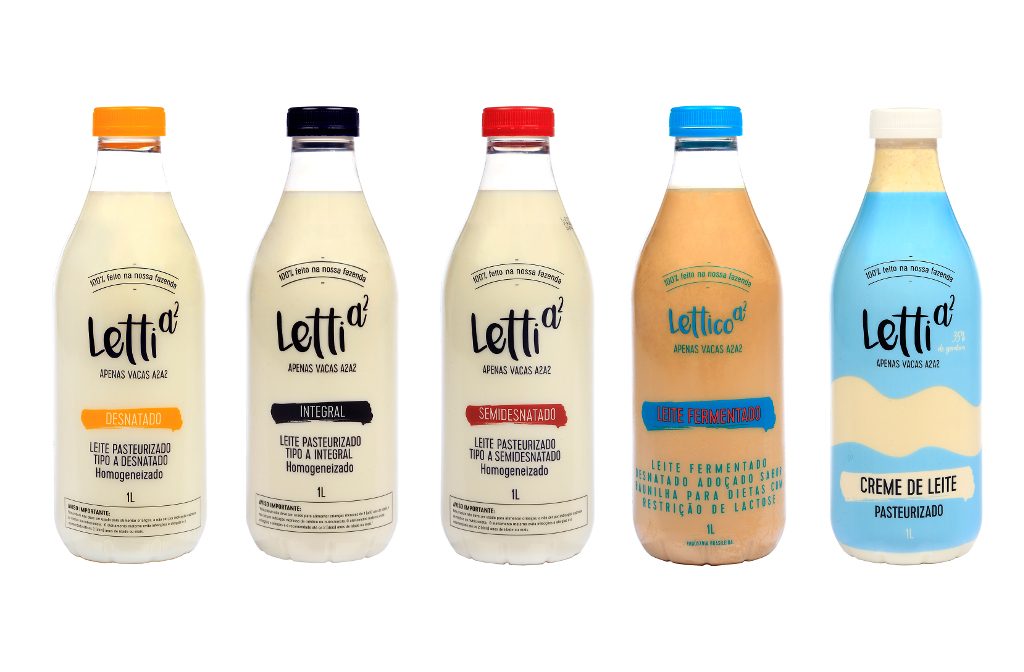A clear vision for the new world of packaging
Amcor has announced a number of new developments, initiatives and innovations to help the packaging and food and beverage supply chain meet the challenges of sustainability, changing consumer demand and growing markets.
We spoke to:
Rodrigo Lecot – Vice President, Commercial Division, Amcor Rigid Plastics-Latin America
Michael Hodges – Vice President of Public Affairs
Brian Carvill – Vice President of R&D and Advanced Engineering, Amcor Rigid Plastics
PETplanet: You recently developed a transparent PET bottle for a Brazilian dairy brand. What was the major factor in the customer switching from HDPE to PET?
Rodrigo Lecot: Amcor research found that Latin American consumers are increasingly attracted to transparent dairy packaging, which conveys freshness and premium quality. Dairy companies like Brazil’s Letti are trending towards using clear PET bottles, which showcase the dairy product and respond to the consumers’ desire for freshness.
PETplanet: How did you make the transparent bottle suitable for UV-sensitive content?
Rodrigo Lecot: The container includes an ultraviolet (UV) blocker to maintain clarity in the cold chain. Our research also uncovered a consumer preference for the “vintage” or traditional dairy bottle design. The Letti fermented milk bottle incorporates an easy to open, one-step closure system with a screw cap on a 38 mm finish. This closure was selected to convey security. It eliminates the foil seal barrier typically found on HDPE bottles.The one-litre PET bottle also features an optimised base for improved bottle structure. Thicker wall sections help to avoid deformation, improve drop resistance and permit the use of heat-shrink labels, without any need for horizontal ribs in the bottle design.
PETplanet: What are your growth forecasts for PET in the dairy sector? Are there any regional variations?
Rodrigo Lecot: The drinkable dairy market has grown, although PET’s share is currently small – so there is strong potential for growth.
The LATAM (Latin American) dairy segment is an important element of Amcor’s rigid container business. We have seen strong activity in response to changing consumer preferences and the growing use of PET as a replacement for HDPE in dairy packaging. We expect the trends towards recyclability, preference for transparent packaging, desire for ‘natural’ products and demand for freshness will continue with growing population, increased urbanisation, and economic improvement.
PET & sustainability
PETplanet: Consumers are increasingly aware of the issues surrounding use of plastic. On social media, the plastic bottle is often symbolised as a careless use of resources and a growing waste problem; a lot of inaccurate information is being put about. How are you, as a manufacturer, dealing with this?
Michael Hodges: In January 2018, Amcor announced a commitment to develop all our packaging to be recyclable or reusable by 2025. We also pledged to significantly increase our use of recycled materials and drive more recycling of packaging around the world.
That pledge means that Amcor joined other leading companies, most of which are customers, who have made the same commitment in collaboration with the Ellen MacArthur Foundation New Plastics Economy initiative.
PETplanet: Amcor signed the ‘Global Commitment’ in October 2018. What does it mean?
Michael Hodges: The Global Commitment unites businesses and governments around the world to create a plastic system that works. It is a vision of a New Plastics Economy, where plastics never become waste.
The Commitment encourages a “race to the top”, and is unprecedented in scope, involving producers, brands, retailers, investors, recyclers, as well as governments, NGOs, and others.
The list of over 250 signatories includes many Amcor customers, such as The Coca-Cola Company, Colgate-Palmolive Company, Danone SA, Diageo, Johnson and Johnson, L’Oréal, Mars Incorporated, Nestlé, and PepsiCo.
PETplanet: Did your customers also express any reservations about the use of PET yet?
Michael Hodges: Many of our customers have goals to address the environmental footprint packaging leaves behind if it isn’t properly collected. We are working with them to meet those objectives with innovative packaging, improved formats, better technologies and even more sustainable materials.
We take a lifecycle approach to packaging design. This means selecting the right raw materials, in the right quantities, to protect customer’ products and minimise environmental impact. For example, we use proprietary technologies to lightweight our bottles to reduce usage of raw materials, while maintaining protection of customers’ products.
We know that the environmental profile of the packaging we design and make, and the efficiency of our operations, must and will, constantly improve.
PETplanet: Minimum content of rPET per bottle, tethered caps, recyclability and re-use – new regulations are constantly being introduced that focus on PET as a resource and which also demand environmentally responsible use of packaging. How do you keep track of all these market requirements? Which of them do you think are really appropriate and what progress has been made in your developmental work on sustainability issues?
Michael Hodges: We are also collaborating with suppliers to increase the quality and supply of post-consumer recycled (PCR) – resins.
Sustainability and R&D experts from Amcor monitor and join conversations with governments, NGOs and associations to bring the best solutions to the forefront.
We have established clear baselines around our current product recyclability, which is directing our innovation decisions. We will also work with others to drive consistently greater worldwide recycling of packaging.
One of Amcor’s newest service offerings, called Amcor 360 Packaging Solutions, is expected to deliver improved sustainability along with more efficient supply chains, capital avoidance, and superior shelf impact. Amcor 360 is powered by LiquiForm, a forming and filling technology where liquid product instead of air forms and fills the container in one step.
Trends in PET
PETplanet: Market research institutions repeatedly cite e-commerce as the major customer phenomenon over the next few years. It is currently seeing significant growth in the food sector, a trend which is likely to continue going forward. What role does the bottle design have to play in this process?
Brian Carvill: Primary packaging plays an important role in protecting products throughout the e-commerce supply chain.
The bottle/container offers greater sustainability impact versus other packaging formats in the e-commerce channel. A lifecycle review shows that lighter containers reduce transportation needs, reduce damage, and cut emissions. Sound e-commerce packaging also reduces food waste, one of the greatest contributors to greenhouse gas emissions.
Amcor is helping businesses, large and small, meet rising consumer expectations for convenient, more sustainable and unique packaging that endures the complexities of the e-commerce supply chain.
PETplanet: What innovations has Amcor introduced that are taking packaging forward in the e-commerce world?
Brian Carvill: E-commerce is driving the food category and APEX patented technology is a great fit in that space and one of many evolutionary steps that Amcor has undertaken.
The company’s unique APEX 24 oz hot fill PET jar with a metal lug closure is a first for the food packaging industry. The use of hot fill PET containers brings a unique value proposition and can be an integral element in an e-commerce expansion strategy for those brand owners who sell premium products in glass at leading national retailers and specialty stores. PET is unlocking this untapped/incremental market for many brands beyond the retail space.
The technology allows the fitment of metal lug closures to blow-and-trim 24 oz hot fill containers. For the first time, consumers who are familiar with the look and quality feel of a glass jar with a metal lug closure can now enjoy the same quality and reassurance on a lightweight, shatter-proof PET jar. The Apex system ensures that sealing integrity is maintained and meets the industry average for removal torque (ease of opening). Brand owners can also maintain the same brand equity with the switch from glass to PET.
PETplanet: There is an increasing demand for customised products, which is linked to the use of digitisation. What approaches are currently being developed in Amcor and what are your hopes for them?
Brian Carvill: We are working to develop not just PET bottles and containers in a range of sizes to address the needs of brands and e-commerce, but also e-commerce related services. Transportation and freight costs, durability, and weight reduction remain a key focus of R&D. Our design studio, along with its engineering and manufacturing teams, work together to develop beautifully branded containers that are lighter than glass, less fragile and less costly to handle.
Amcor’s robust stock bottle portfolio has enabled new table sauces entrants to compete with leading brand companies, via e-commerce.
PETplanet: We know that products on supermarket shelves have to compete for space and attention. Is the e-commerce channel less dependent on appearance?
Brian Carvill: To thrive in a virtual supermarket, food and beverage brands should not only aim to attract the attention of the digitally engaged food shopper, but also package their products in a form that can withstand the rigours of an extended supply chain.
Logistical considerations aside, a consumer might not select a product in the first place if it doesn’t look attractive. Since they can’t physically handle the item in the online space, visual appeal plays a vital part in determining whether a food or beverage item ends up in their virtual shopping cart. The end user wants to be able to recognise the brand, even if the packaging might have been designed to cater to other considerations. One of the biggest advantages here is the versatility of our materials and the host of options we can make available to meet customer needs.
Amcor offers solutions to our customers beyond simply packaging. We are developing partnerships and engaging with customers in new ways so that all parties can take advantage of e-commerce opportunities.
PETplanet: What other trends are you addressing in relation to PET bottles?
Brian Carvill: Centre stage is innovative design and lightweighting of plastic packaging, for a diverse range of end-use applications including soft drinks/water, juices/teas, food, sports drinks, personal-care, and wine and spirits. Lightweighting capabilities can help reduce resin demands and decrease finished container weight while still producing a highly functional and high-performing container.
In addition to enhancing brand equity, using PCR PET and HDPE has several environmental benefits. Recycling reduces the amount of plastic sent to landfill and supports the recycling infrastructure. Using recycled PET or HDPE means that less petroleum is needed to make new, virgin resin. They materials also require less energy to produce and have a lower carbon footprint (50% fewer carbon emissions) than virgin PET or HDPE.
There is no doubt that the fundamentals of packaging are evolving. Primary packaging for ecommerce is spawning the development of new innovations that bring new value. The connection between package, product, and consumer is changing, and creating an entirely new generation of packaging.
PETplanet: Thank you very much!





